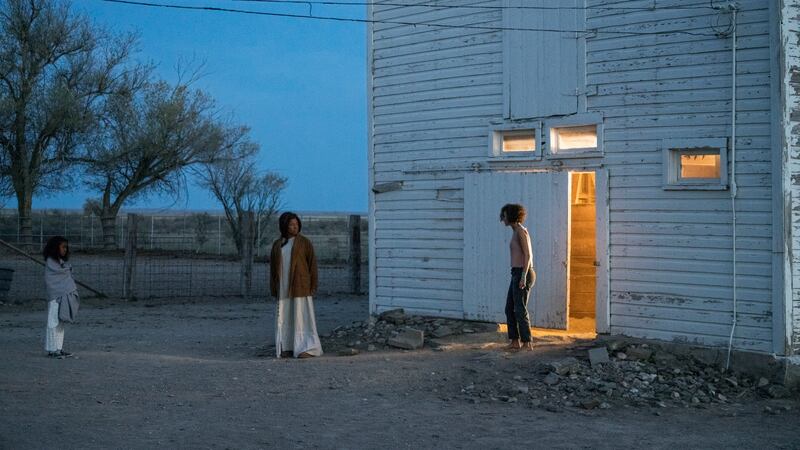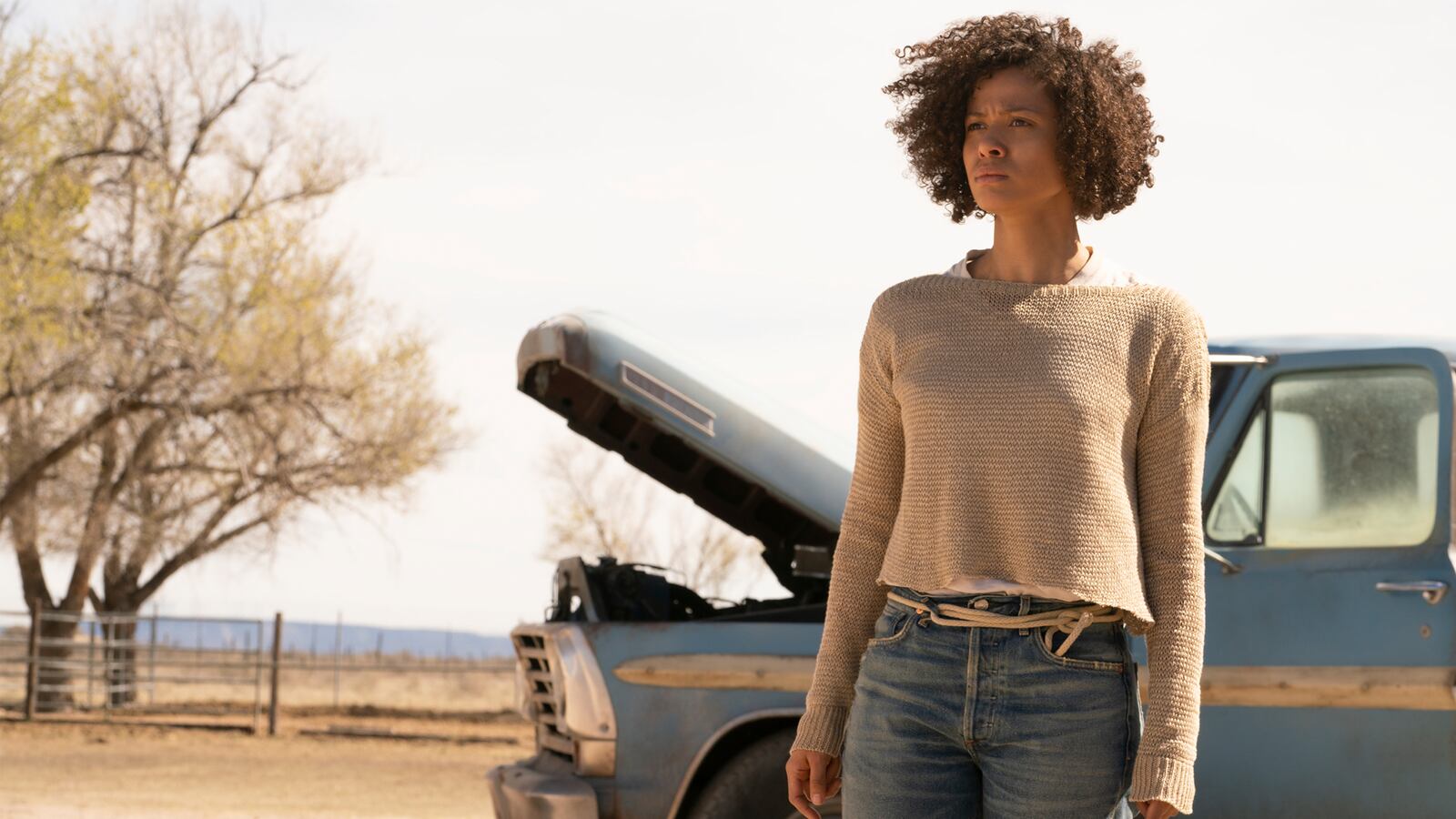Fast Color is exactly what big-budget superhero movies never dare to be.
It’s original, atmospheric rather than action-driven, and centered on a cast of Black women. Unlike the blockbusters that have dominated the last decade of pop culture, writer-director Julia Hart’s second feature imagines world-saving acts of heroism more peaceful and productive than city-toppling slugfests. There’s never been anything quite like it.
“Most quote-unquote superhero movies are about white men destroying things in order to save them, which doesn’t really make any sense when you think about it,” Hart says with a laugh, sitting in a hall with me at Barnard College. “We wanted to tell a story about women’s ability to create in order to save things.”
Hart’s indie, which is in theaters now, plays like a naturalistic, small-scale X-Men story about a young woman on the run from her own demons (and insidious government agents) in a world literally dying of thirst. She’s a mother, a recovering addict, plagued by an uncontrollable ability to violently convulse the earth around her—and descended from a line of black women who’ve hid their unique powers for generations.
In this movie, the way women “come together and talk and put things back together” is a superpower in itself, visualized through gorgeous special effects. Bo, played by the formidable Lorraine Toussaint (Orange Is the New Black), can dissolve objects and reassemble them exactly as they were, flaws and all. Her little granddaughter, Lila (Fences and Hidden Figures’ Saniyya Sidney), has the same ability, plus an uncanny knack for fixing broken machines. Both live together on the farm where Bo grew up, in a barren (yet beautifully photographed) stretch of land somewhere in Middle America.

Gugu Mbatha-Raw, Saniyya Sidney and director/Writer Julia Hart attend "Fast Color" Premiere at SXSW at Paramount Theatre on March 10, 2018, in Austin, Texas.
Sarah Kerver/GettyIt’s been years since they’ve seen Lila’s mother, Ruth (Gugu Mbatha-Raw)—until she turns up out of the blue, desperate, just out of the reach of an exploitative government scientist who wants to “study” her.
Unlike her mother and daughter, Ruth’s earth-shaking power is destructive; it’s a symptom of losing her connection to family and their shared, restorative ability. Her journey then is one of re-self-discovery that leads all three women to emerge from hiding and own their powers—a story with universal enough themes that take on heightened, specific resonance with Black female characters. (In one powerful scene, Bo dissolves the handguns police officers and government agents point at her, a gentle yet effective stand against violence.) Still, Hart and her co-writer/husband, La La Land producer Jordan Horowitz, didn’t write the story with Black characters in mind.
“I think for the most part creators, when they’re imagining characters—and I’m guilty of this myself—picture people that look like them,” she says. “It’s why we’ve ended up with so many white male stories, because white men get to tell most of the stories.” The couple happened to watch Gina Prince-Bythewood’s Beyond the Lights for the first time while writing Fast Color, however, and were stunned by Mbatha-Raw’s “incredible,” multilayered performance. They decided to send her their script—and were shocked when the English actress signed on right away.
An only child “mostly brought up by my mum,” Mbatha-Raw connected to the script’s matriarchal bent, and found its omission of any specific racial identity “liberating”: “These women just happened to be Black and they happen to have these abilities,” she says by phone from Los Angeles. Not that she denies the impact three Black women with superpowers carries on a big screen. “This is America and the world we live in, and I think we’re not accustomed to women of color with superpowers—who are mothers!” she adds with a laugh. “There’s something so refreshing about that. Images are powerful, optics are powerful because they go into our subconscious and tell us who gets to be the hero, who gets to be the victim, who gets to save the day.”
Hart cast Toussaint and Sidney after locking down her lead actress. “It was an incredible journey that started with just thinking she’s the best actress for the part, which is what you always want to cast,” she says. “But the fact that she happens to be of color just made the story and the movie and the other casting that much richer and more beautiful.”
There’s certainly room for a story like Fast Color’s, even in a crowded comic-book landscape. In the last ten years, Mbatha-Raw says, “we’ve reached a saturation point of a certain kind of superhero. I think that it’s exciting to see as a breath of fresh air a different perspective, to know you don't have to have a suit or a cape or a weapon to be powerful. That actually connecting to who you are, connecting to your family, connecting to your roots, and motherhood itself bringing new life into the world are all superpowers.”
For Hart, the idea of owning one’s power is personal. She had dreamt of being a writer for years while working as a schoolteacher—a job she took to subsidize that writing—but found herself losing touch with that ambition as she “fell in love” with teaching. “Then I woke up one day and I was like, I’m gonna regret it if I never give it a shot,” she remembers. Her first screenplay, a story about three women defending their home from rogue soldiers during the Civil War, was adapted into 2015’s The Keeping Room, co-starring Brit Marling and Hailee Steinfeld. As she watched a male director bring her movie to life, however, it hit her.
“I was just like, oh my god, I am hiding. I could be doing this, I have the power to do this, and instead I am letting men have it,” she recalls. It was the process of “becoming comfortable with and accepting and expressing my own power as a woman” that helped inspire Fast Color, “because we do that. We hide our power because it makes men angry when we’re powerful and that causes problems for us in the workplace. And so a lot of the time, women only share their powers with each other, which is what these women have been doing for generations. Until finally they’re like, we’ve hidden our power for so long that the world is actually suffering because it doesn’t have us and our voices. It’s time to let it out.”
It’s an especially timely message in 2019, when women in Hollywood and beyond have funneled years of suppressed anger into forces for change. “Whether it’s through ascribing to conventional norms or self-sabotage, I think culturally perhaps women have had a history of making themselves more appealing and pleasing,” Mbatha-Raw says. She draws a parallel from the Fast Color women to the Time’s Up and #MeToo movements, and demands for “such simple things” as equal pay. “Like Ruth shifting these tectonic plates, there has been a pretty seismic shift.”
Hart sees it, too, in the freshman class of congresswomen and its radical new female leaders. When we meet on a snowy March morning at Barnard, in a hall surrounded by portraits of the college’s past female presidents, it’s been two days since Alexandria Ocasio-Cortez, Rashida Tlaib, and Ayanna Pressley grilled Trump lawyer Michael Cohen and stared him down as a trio in a now-iconic shot.
“You watch them in that hearing and they were the most articulate, the most well-studied, the most thoughtful, the most passionate—I mean, the amount of B.S. that has been going on in those halls for decades because men are letting each other lie to each other and aren’t holding each other accountable,” she says, “and then these women walk in there and they’re telling it like it is and it’s remarkable. It’s so exciting to think that that’s potentially our future, if we can get our shit together.”
Hart’s pivot to directing came only after she gave birth to a baby boy; at Fast Color’s premiere at last year’s SXSW festival, she took the stage pregnant with her second. Thinking of the year in between, and where it’s led her as a mother and director, makes her teary-eyed. She laughs and fans her eyes, blushing only slightly, and tells me her favorite story from set: the first day her older son, Arthur, visited. “He asked our nanny, ‘Why is everyone looking at Mama?’” she recalls, beaming. “And our nanny said, ‘Because mama’s in charge.’ Just the idea of him and our other son having that image in their heads, of a woman being in charge and being a leader, is very powerful to me.”

It should be, as Hollywood is still warming up to the idea of supporting and funding female directors’ visions. “Unfortunately when you’re telling female stories, everybody always wants to meet you so that they can say that they met with female creators, but then they always find a reason to pass,” Hart says. It was LD Entertainment’s Mickey Liddell and Pete Shilaimon who backed Fast Color “immediately” and launched it into production within a year. “I can’t imagine it made any financial sense,” Hart laughs. “They just believed in it and believed that stories about women and women of color needed to be told. We need more people like them who have the power to say yes, to say yes to stories like this.”
Mbatha-Raw had just come off a string of leading roles in more expensive films like Cloverfield Paradox and A Wrinkle in Time—“big special effects, a lot of work on sound stages, a lot of green screen work,” she recalls—when she signed on to Hart’s indie. For her, it was a chance to do something “raw and stripped-down”; she was also drawn to Ruth’s “fight-or-flight, adrenalized, woman-on-the-run vibe.” It’s the kind of “meaty, nuanced” role she’s become known for performing for female directors. “And that’s really the truth of it,” she says. “It’s really my normal.”
Helping craft complex characters “from the female gaze” is a specialty of Mbatha-Raw’s, and “invariably, that means those often come from women” writers and directors, she says. As Ruth, she works to heal herself and the bonds of her family—as the film visualizes it, she strives to see the pulsing race of colors that connect living things, and which only the women of her family (and maybe other women they’ve yet to meet) can see. When the breakthrough comes, it’s a soaring, uplifting thrill, like the moment another superhero first learns to fly.
Ruth’s journey to re-accessing her ability, Hart explains, mirrors the way women who use their power “all see this beautiful world underneath that men don’t see.”
Mbatha-Raw finds the image potent, too. “In the grand scheme of things, we are sort of the leading edge of evolution of generations and generations of powerful who have survived to create us, you know?” she says. “That’s just in our DNA, whether we acknowledge it or not.”
Correction: An earlier version of this article mistakenly stated Hart is an alumnus of Barnard College. She graduated from Columbia College.

